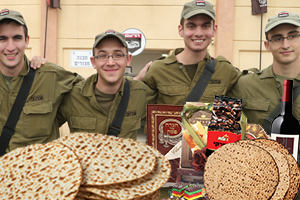

No visit to the Ramon Crater would be complete without a visit to the Ein Sahoronim stream in the central Negev desert.
A Nabatean Inn and Roman Fortress next to the Ein Saharonim stream tells a story of the ancient spice route and the Roman legion camps during the later years of the Second Temple period. (In Jewish history, the Second Temple period lasted from 530 BCE until 70 AD.)
The inn (or khan, in Arabic) was built by the Nabateans, an ancient Arab tribe, along the Incense and Spice Route in the first Century BCE. It was strategically located along the spice route as a rest stop for weary merchant traders, their camels and horses. It was a fortified place of safety from bandits, thieves, robbers and the Roman legion who sought to attack the Nabateans.
Located along the only spring in the Makhtesh Ramon (Makhtesh is a geological landform unique to the Negev and Sinai peninsula), it provided a valuable source of water in the arid Negev Desert.
The Nabateans were masters at finding water in the parched desert soil. Just look at these thick walls and the lack of a tower. This is because this was a khan, and safety from the elements was the key, not fortifications. It measures approximately 42 x 42 meters squared. There were two floors. The first floor was for the animals: donkeys, horses and camels, and storage of goods. The second was for human beings: accommodations for sleeping and for perhaps drinking a toast with their friends or to enjoy a good meal. Note the structure built with arches and pillars to maximize space and the large courtyard where trading and exchanging of goods may have occurred.
Years later the Romans conquered the Nabateans and wiped out their empire. They may have used this site for an army garrison or perhaps also as an inn. It fell out of use for centuries until the Crusaders came to the Negev; they may have used this site as a trading centre for their merchant ventures. Perhaps there was a silversmith, a blacksmith or a tanner, or maybe even a small tavern where knights could buy a beer.
Today we visit the ruins as tourists hiking through the makhtesh. The site is along the World Heritage Spice route. We can see firsthand how ancient merchant traders traveled and lived courtesy of the National Parks and Nature Reserve Authorities, which have preserved this site.
Daniel Ashkenazy is an educator, writer and tour guide living in Jerusalem
Send Passover Packages to Needy Israeli Soldiers - Bring Them Joy!
We are honored to thank the young men and women of the IDF who risk their lives every day to protect the citizens of Israel. Since October 7th, soldiers have been on the battlefield for months - many are hoping to come home for Passover.
Join us in sending Passover food packages (and personal notes) to Israeli soldiers and their families.
Many soldiers spend the Passover holiday with needy families back home. The soldiers greatly appreciate your love and concern. Bring them Passover joy!
CLICK HERE TO SEND YOUR PACKAGE AND NOTE TO ISRAELI SOLDIERS!



